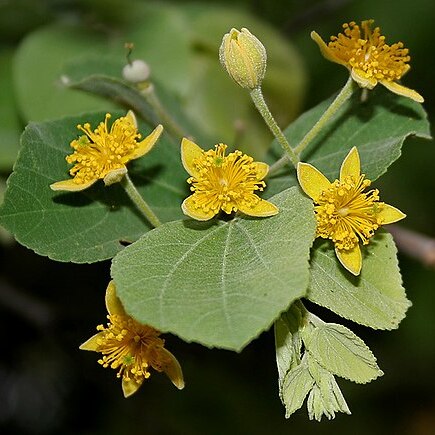Trees 5-8 m tall. Branchlets gray stellate tomentose. Petiole ca. 1 cm, softly tomentose; leaf blade nearly orbicular or broadly ovate-orbicular, (1.7-)8-13(-36) × (1-)6.5-9.5(-24) cm, papery, black-brown when dry, with sparse solitary hairs or glabrescent and hairy only on veins adaxially, lateral basal veins 2/3 as long as leaf blade, 1.5-2.7 cm from margin, each with 5 or 6 secondary veins, dark brown, abaxially sparsely hairy or glabrous, base obliquely cordate, margin serrulate, apex shortly acute. Cymes 2-6 per leaf axil, 3-flowered; peduncle 1-1.5 cm. Pedicel 6-7 mm, gray-brown tomentose. Sepals oblong lanceolate, 7-8 mm, softly gray-yellow tomentose on both surfaces. Petals yellow, shorter and narrower than sepals. Stamens many, in 5 fascicles, slightly connate at base, slightly shorter than sepals. Ovary 2-loculed, hairy; style slightly longer than stamens. Drupe subglobose, not divided; exocarp not separating from endocarp; drupelets 1 or 2. Fl. Apr-Jun, fr. Jul-Aug.
More
A shrub or small tree. It grows 5-8 m tall. They young parts are covered with star shaped hairy scales. The leaves are 7-20 cm long by 6-12 cm wide. They are oval with a pointed tip. The two halves of the leaf blade are unequal. The edge has teeth. They are hairy below. The base is rounded or heart shaped. There are 5-7 veins. The fruit are yellowish. They occur in large clusters of 10-12. The fruit is fleshy with a hard covering over the seed. The fruit has 3-4 lobes and is blackish. They are pea sized.
Can be grown by cuttings or seedlings. Seeds needs soaking.

